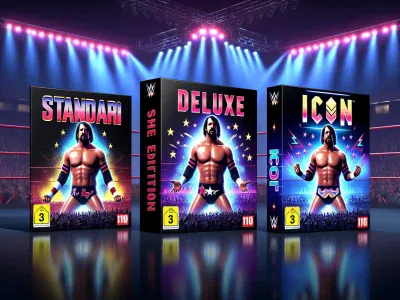Difference Between WWE and WWF: Key Changes, History, and Legacy Explained
Picture flipping through channels and stumbling upon a high-energy wrestling match, the crowd roaring as larger-than-life athletes battle it out in the ring. You might wonder—what’s the difference between WWE and WWF? These acronyms have dominated professional wrestling for decades, but they’re not just letters; they represent two distinct eras of sports entertainment.
Whether you grew up cheering for legends like Hulk Hogan or are more familiar with modern superstars like Roman Reigns, understanding the evolution from WWF to WWE opens up a fascinating story. It’s more than just a name change—it’s about legal battles, branding shifts, and how wrestling transformed into a global phenomenon. Curious about what sets them apart? Let’s jump into the details that shaped these iconic organizations.
Overview Of WWE And WWF
WWE and WWF represent pivotal eras in professional wrestling, influencing global entertainment. Both names symbolize distinct periods marked by transformation and branding.
History Of WWE
WWE stands for World Wrestling Entertainment, established as a rebranding of the former WWF in 2002. The name change resulted from a legal dispute with the World Wildlife Fund over the “WWF” acronym. Following this shift, WWE expanded its focus beyond wrestling to become a comprehensive entertainment company. It introduced reality shows like Total Divas and streaming platforms such as the WWE Network, appealing to diverse audiences worldwide.
WWE’s integration of storytelling and athleticism elevated it into mainstream culture. Events like WrestleMania draw millions annually, showcasing larger-than-life personas like John Cena and Roman Reigns. Its PG-era pivot ensured broader family appeal while maintaining its core fanbase.
History Of WWF
The WWF (World Wrestling Federation) defined professional wrestling during its tenure from 1979 to 2002. Founded by Vince McMahon Sr., it gained prominence through iconic rivalries involving stars such as Hulk Hogan and Andre the Giant during the ’80s wrestling boom.
WWF’s Attitude Era (1997-2002) revolutionized sports entertainment with edgier content targeting adult demographics. Memorable factions like D-Generation X exemplified this era’s provocative style, capturing record-breaking viewership ratings on programs like Monday Night Raw.
Its transition to WWE marked an end of an era but preserved much of its legacy within modern wrestling narratives.
The Key Differences Between WWE And WWF
WWE and WWF represent distinct eras in professional wrestling history, with key differences shaped by legal disputes, branding shifts, and evolving entertainment strategies.
Name Change And Legal Dispute
The transition from WWF (World Wrestling Federation) to WWE (World Wrestling Entertainment) occurred in 2002 after a legal conflict with the World Wildlife Fund. This dispute centered on the shared acronym “WWF.” To resolve it, the wrestling organization opted for rebranding. The name change marked more than just compliance; it symbolized a shift towards broader entertainment pursuits.
For instance, while WWF primarily emphasized in-ring action and rivalries during its peak years, WWE expanded into diverse content formats like movies, reality shows (e.g., “Total Divas”), and digital streaming platforms such as Peacock. This evolution allowed WWE to appeal to global audiences beyond traditional wrestling enthusiasts.
Branding And Marketing Strategies
WWF’s branding leaned heavily on its wrestlers’ personas—Hulk Hogan’s charisma or Stone Cold Steve Austin’s rebellious image defined entire eras. Its marketing revolved around creating larger-than-life heroes and villains that resonated deeply with fans of all ages.
In comparison, WWE adopted a multi-faceted approach. It integrated storytelling across various media channels while leveraging modern technology for fan engagement. Social media campaigns featuring stars like Roman Reigns or Becky Lynch broadened audience reach significantly. Events like WrestleMania became not just sports spectacles but full-fledged entertainment experiences blending music performances and celebrity appearances.
Content And Programming Focus
WWF targeted different demographics over time but gained significant attention during the Attitude Era (1997–2001), characterized by edgy storylines catering to adult viewers. Iconic moments included The Rock’s electrifying promos or controversial matches involving tables and ladders.
On shifting gears post-rebrand, WWE diversified its programming focus to include family-friendly content alongside intense matches. Shows like “Monday Night Raw” maintained wrestling traditions while spin-offs such as “SmackDown” introduced unique narratives tailored for varied preferences within its global fanbase.
Popular Superstars In WWE And WWF Eras
The transition from WWF to WWE brought not only a change in branding but also introduced distinct generations of wrestling superstars. Both eras produced iconic figures who defined professional wrestling and left lasting legacies.
Iconic WWF Wrestlers
WWF’s roster during its peak years featured legendary athletes whose personas captivated millions. Hulk Hogan, known for his “Hulkamania” movement, symbolized the golden era of the 1980s with his larger-than-life charisma and memorable catchphrases. The Undertaker emerged as a supernatural figure, debuting in 1990 and later becoming synonymous with WrestleMania through his undefeated streak that spanned over two decades.
Bret “The Hitman” Hart earned acclaim as “the best there is, the best there was, and the best there ever will be,” blending technical prowess with compelling storytelling inside the ring. Meanwhile, Stone Cold Steve Austin revolutionized the industry during the Attitude Era; his rebellious anti-hero persona resonated deeply with fans and fueled record-setting viewership numbers.
Dwayne “The Rock” Johnson rose to fame in this period as well, combining electrifying mic skills with impressive athleticism. His feuds against Triple H or Mankind showcased some of WWF’s most unforgettable moments. Other standout names include Shawn Michaels (“Mr. WrestleMania”) for his show-stopping performances and André the Giant for embodying true spectacle in size and ability.
Modern WWE Superstars
WWE’s modern era expanded beyond traditional wrestling archetypes by introducing stars who excel across industries like entertainment or social media engagement. John Cena became an emblematic figure during this time; leveraging crossover appeal into film roles while maintaining dominance within WWE rings through numerous world championship reigns.
Roman Reigns represents today’s top-tier talent—his transformation into “The Tribal Chief” solidified him as both a polarizing character among fans yet undeniably dominant competitor across events such as SummerSlam or Royal Rumble (2021). Becky Lynch broke barriers by headlining WrestleMania 35 alongside Charlotte Flair & Ronda Rousey—the first women ever granted such spotlighted main-event status at this flagship pay-per-view event!
Cultural Impact Of WWE And WWF
The cultural significance of WWE and WWF stems from their ability to shape entertainment, influence audiences, and redefine professional wrestling. Both periods left lasting marks on global pop culture.
WWF’s Influence In The Past
WWF played a pivotal role in popularizing professional wrestling from 1979 to 2002. It introduced larger-than-life characters like Hulk Hogan, whose “Hulkamania” movement transcended the sport, captivating millions globally. Stone Cold Steve Austin and Dwayne “The Rock” Johnson dominated the Attitude Era with rebellious personas that resonated with adult demographics during the late 1990s.
Iconic rivalries such as Bret Hart vs. Shawn Michaels showcased intense storytelling while legitimizing wrestling as a dramatic art form. Events like WrestleMania revolutionized live sports entertainment by combining athleticism with theatrical spectacle. WWF also influenced mainstream media through collaborations in movies, TV shows, and music, cementing its stars as household names.
WWE’s Global Reach Today
WWE expanded beyond traditional wrestling into a multimedia empire after rebranding in 2002. It leveraged digital platforms like Peacock and WWE Network to reach over one billion households across more than 180 countries (source: WWE Corporate). Flagship events such as WrestleMania continue attracting millions of viewers annually while driving tourism revenue for host cities.
Modern superstars like John Cena transitioned seamlessly into acting careers, amplifying WWE’s visibility in Hollywood. Roman Reigns’ dominance reflects an era where social media interaction enhances fan engagement worldwide. Women’s Evolution campaigns spotlighted athletes like Becky Lynch and Charlotte Flair, breaking barriers for female wrestlers on global stages.
Conclusion
Understanding the difference between WWE and WWF gives you a deeper appreciation for how professional wrestling has evolved over the decades. Both eras have left unique imprints on sports entertainment, shaping it into the global phenomenon it is today.
Whether you’re drawn to the nostalgic intensity of WWF or the diversified storytelling of WWE, each era offers something special that continues to captivate fans worldwide. The legacy of these organizations highlights their impact not just in wrestling but across mainstream culture and entertainment.
- Understanding the Difference Between Oath and Affirmation: Key Facts You Need to Know - October 30, 2025
- Understanding the Difference Between Annulled and Divorced: Key Legal and Emotional Insights - October 30, 2025
- Ibuprofen vs. Aspirin: A Comprehensive Comparison - October 30, 2025







